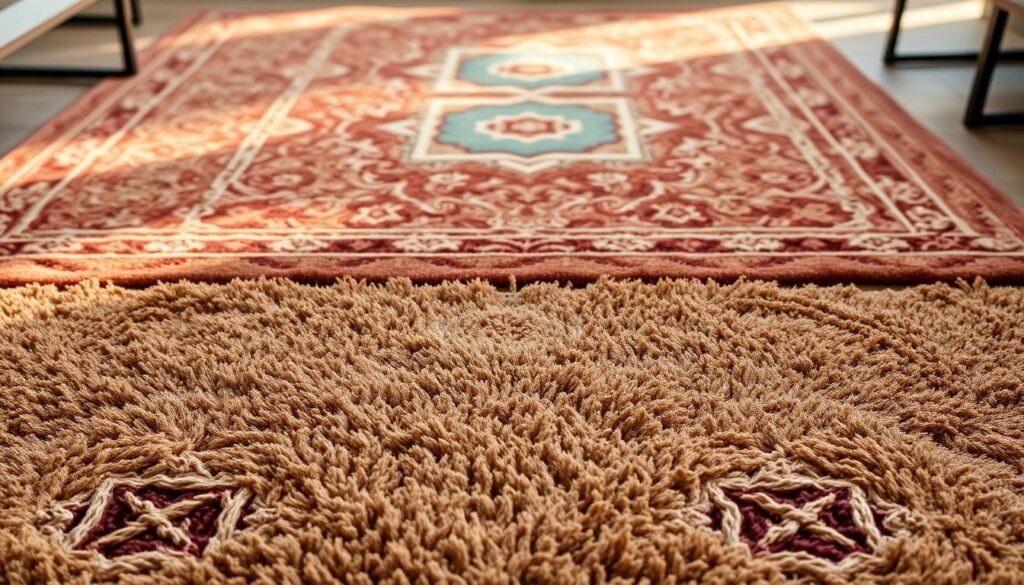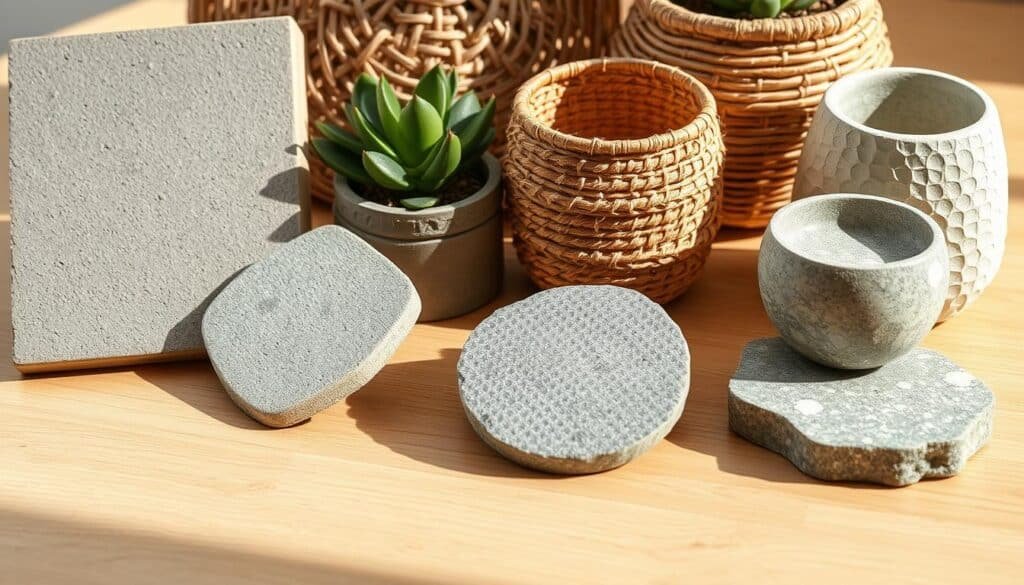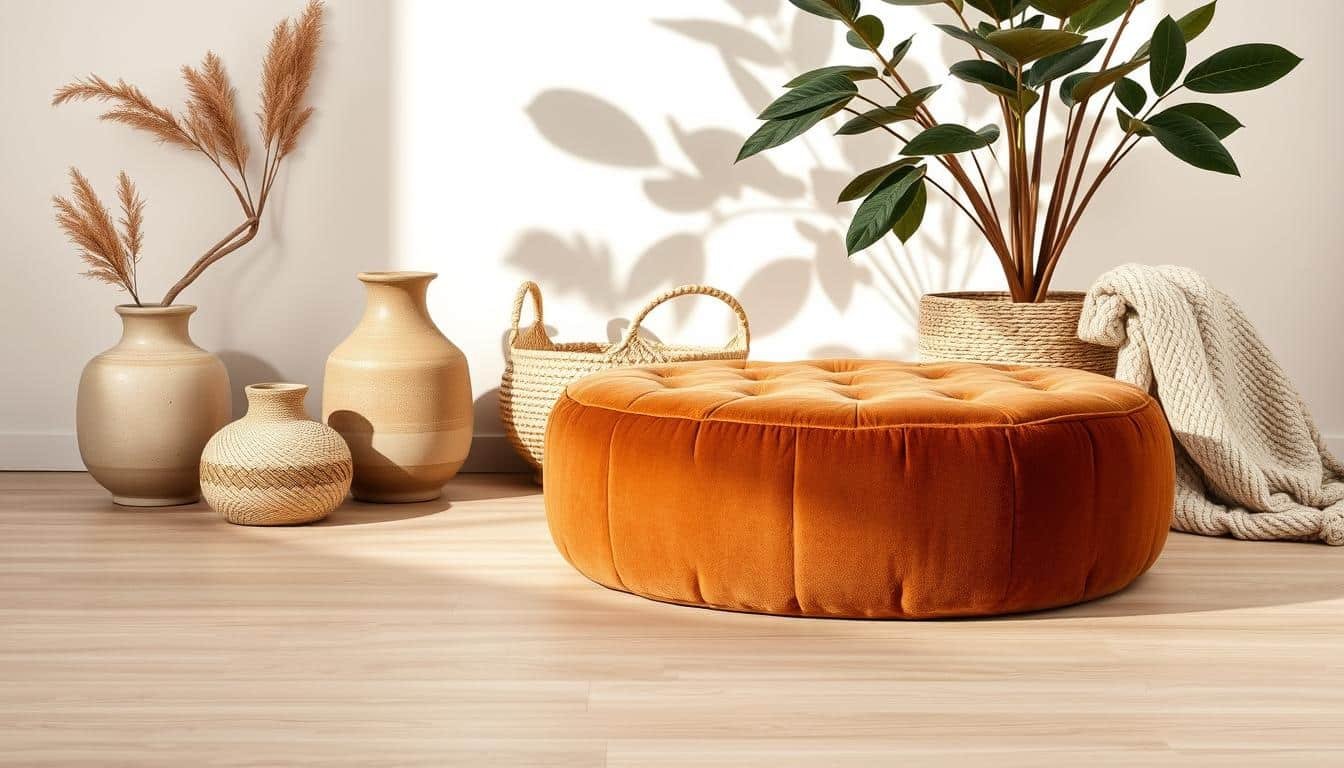This post may contain affiliate links. When you purchase through links on our site, we may earn an affiliate commission.
I’ve always believed that the magic of a room lies in its layers. While sleek lines dominate contemporary aesthetics, something feels missing. What if I told you that flat surfaces alone can’t create the warmth we crave? This realization reshaped how I approach interior design.
Take crushed velvet, for example. Designer Brad Ford once called it a “quiet game-changer” for modern furniture. When layered over clean-lined sofas, it adds depth without overwhelming the eye. But texture isn’t just about fabric – think ribbed ceramics or woven wall panels that beg to be touched.
Through trial and error, I discovered how tactile elements transform sterile areas into inviting environments. My favorite projects balance matte finishes with rough-hewn woods, proving that contrast drives visual interest. Later, I’ll share how to mix these elements like a pro.
Key Takeaways
- Texture creates emotional connections in minimalist rooms
- Combining tactile and visual elements adds luxurious depth
- Materials like crushed velvet elevate basic furniture pieces
- Textured accents influence a space’s mood and personality
- Strategic layering techniques prevent visual overload
Understanding Texture in Modern Spaces
Walking into a room, the first thing I notice isn’t the color scheme or furniture layout – it’s how surfaces invite interaction. Texture shapes our experience before we consciously realize it. Interior designer Mara Berendt once told me, “Rough stone walls whisper stories, while satin drapes hum lullabies.” This sensory dance defines a space’s personality.
https://www.youtube.com/watch?v=MQkArSvxCes
The Role of Texture in Creating Mood and Ambiance
I’ve seen linen curtains transform sterile offices into calming retreats. Tactile textures like nubby wool throws or hammered metal lamps demand physical engagement. Visual textures work differently – a zigzag-patterned rug can energize a room without changing its feel. The key lies in balancing both types to craft layered experiences.
Tactile vs. Visual Textures: Defining the Essentials
Here’s how I distinguish them:
| Type | Experience | Best Uses | Examples |
|---|---|---|---|
| Tactile | Physical touch required | Focal points | Bouclé chairs, raw-edge wood |
| Visual | Perceived through sight | Background elements | Marble-print wallpaper, geometric tiles |
Mixing these creates magic. Pair smooth leather sofas with chunky knit throws – the contrast sparks interest. My go-to tip? Use three tactile elements for every visual pattern to maintain balance. This approach turns flat rooms into dimensional stories worth exploring.
Showcasing “Textured Home Accessories for Modern Spaces”
During a recent project, I stumbled upon a concrete wall that changed my perspective. Rad Design Inc’s exposed structural elements paired with walnut shelving proved industrial doesn’t mean cold. This marriage of raw materials and organic warmth creates spaces that feel both edgy and welcoming.

Highlighting Industrial and Natural Elements
ModularArts’ oxidized steel tables taught me how metals gain character over time. Pair them with live-edge wood stools, and you get instant depth. Decorilla designers often use this trick – think brushed nickel lamps atop reclaimed oak consoles.
| Element Type | Materials | Design Effect | Room Use |
|---|---|---|---|
| Industrial | Concrete, steel | Adds structural drama | Kitchen islands, accent walls |
| Natural | Reclaimed wood, stone | Softens harsh lines | Furniture, decorative bowls |
Glass accents became my secret weapon last year. A ribbed vase beside rough-hewn shelves introduces light play without clutter. One client’s loft transformed when we layered flax linen drapes over steel-framed windows – the space whispered “urban oasis” perfectly.
For balance, I follow a 2:1 ratio – two natural textures for every industrial piece. Try pairing hammered copper planters with smooth travertine side tables. The contrast feels intentional, not chaotic, especially in open-concept areas craving definition.
Layering Techniques and Color Trends in Home Decor
What if your room could tell a story through its surfaces? Designers at The Sky Is The Limit Design recently showed me how modular wall panels paired with strategic layering create narrative depth. This approach turns flat spaces into dimensional experiences that engage both eyes and fingertips.

Layering for Warmth and Depth
I tested Decorilla’s signature trick last winter – stacking a sheepskin rug over jute flooring. The result? Instant coziness without sacrificing clean lines. Try these combinations:
- Knitted throws draped over leather armchairs
- Woven baskets under glass coffee tables
- Fringed cushions on smooth velvet sofas
My living room transformation taught me that contrast drives interest. A raw-edge walnut console against matte black walls became the star of my space. Natural materials like unpolished stone bookends add organic balance to sleek furniture.
Playing with Paint and Pattern to Add Interest
2025’s color trends demand courage. I’m loving terracotta paired with sage green – a combo that feels both earthy and fresh. For risk-averse spaces, try this Decorilla-approved formula:
“Base walls in warm putty tones, then add geometric patterns in metallic copper through removable decals.”
In my studio, I created depth by sponge-painting concentric circles behind floating shelves. The secret? Use three coordinating hues from the same color family. This technique adds movement without overwhelming small rooms.
Remember: bold doesn’t mean busy. Pair statement walls with solid-colored textured rugs to ground the design. Your eyes need resting spots to appreciate the drama.
Expert Tips and DIY Ideas for a Richer Interior Design
Renovating a client’s loft last month taught me how professional wisdom and hands-on creativity can coexist beautifully. Let’s explore how top designers approach texture-rich spaces – and how you can recreate their magic affordably.

Advice from Leading Designers and Trend Insights
Noha Hassan Designs swears by oversized shag rugs: “They ground open-plan rooms while adding sensory softness.” For paint techniques, Tiffany Hanken suggests sponge-dabbing metallic glaze over matte walls. Key trends for 2025 include:
- Mixing matte finishes with glossy accents
- Using organic shapes in furniture legs
- Layering monochromatic textures for subtle contrast
Incorporating Sustainable and Handcrafted Pieces
My go-to trick? Pair mass-produced items with artisanal touches. Try these eco-friendly swaps:
| Common Item | Sustainable Alternative |
|---|---|
| Plastic bowls | Hand-thrown clay vessels |
| Polyester throws | Organic cotton kantha quilts |
Decorilla’s team recommends local craft markets for unique pieces that tell stories. I recently framed a vintage textile as wall art – it became my living room’s conversation starter.
Practical DIY Enhancements for Texture-Rich Spaces
Transform basic furniture with these budget-friendly ideas:
- Wrap chair legs in jute rope
- Stencil geometric patterns on plain curtains
- Layer throw pillows in varying fabrics
“Discreet tech integration lets you enjoy modern conveniences without sacrificing craftsmanship.” – Decorilla design team
My favorite project? Converting an old ladder into a textured blanket rack using reclaimed wood rungs. It proves that interior design magic often lives in the details.
Conclusion
Design thrives when surfaces speak louder than colors. Through blending industrial metals with organic woods, layering woven throws over sleek furniture, and choosing sustainable materials, we craft spaces that feel alive. My experiments prove even one nubby pillow or ribbed vase can shift a room’s energy from sterile to soulful.
Remember: texture isn’t just visual – it’s an invitation to touch. The magic happens when matte ceramics meet hammered brass lamps, or when linen drapes frame concrete walls. These contrasts create luxury through contrast, not cost.
Here’s my final tip: Start small. Drape a chunky knit over your sofa, or place a stone coaster beside smooth glassware. Notice how these elements influence your mood. Does the room feel cozier? More dynamic? That’s texture working its quiet magic.
Now it’s your turn. Which textured piece will you introduce first? Whether revitalizing a single corner or reimagining your entire space, remember – great interior design lives in the balance between what we see and what we feel.





 using WordPress and
using WordPress and 
No responses yet